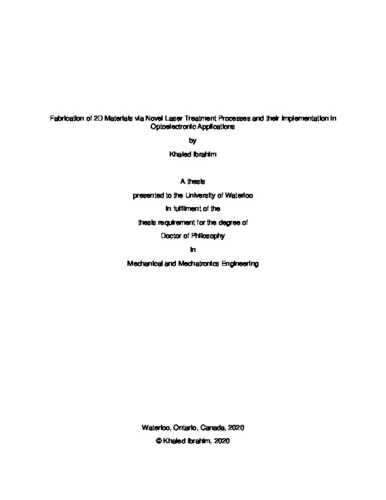UWSpace will be migrating to a new version of its software from July 29th to August 1st. UWSpace will be offline for all UW community members during this time.
Fabrication of 2D materials via novel laser treatment processes and their implementation in optoelectronic applications
| dc.contributor.author | Ibrahim, Khaled | |
| dc.date.accessioned | 2020-06-01 14:02:40 (GMT) | |
| dc.date.available | 2020-06-01 14:02:40 (GMT) | |
| dc.date.issued | 2020-06-01 | |
| dc.date.submitted | 27-05-27 | |
| dc.identifier.uri | http://hdl.handle.net/10012/15964 | |
| dc.description.abstract | Pulsed laser treatment of 2D materials is becoming increasingly popular due to the simple and efficient nature of the treatment process. In this thesis, the femtosecond laser treatment methods of 2D materials to fabricate functionalized particles and nanorods are proposed to deepen the understanding of how the femtosecond laser and the process parameters can be tuned to yield different chemical compositions and shapes, which in turn can fit different applications and devices. A femtosecond laser process was developed to treat flakes of 2D materials (molybdenum disulfide (MoS2), tungsten disulfide (WS2), and boron nitride (BN) flakes) in an ethanol-containing solvent. The highly energetic laser pulses exfoliate and cleave the flakes into nanosheets with diameters of ≈3 nm and simultaneously dissociate the solvent molecules. The dissociated carbon and oxygen atoms from the solvent bond with the freshly cleaved 2D nanoparticles to satisfy edge sites, resulting in the formation of hybrid 2D nanoparticles that contain graphene-like carbon domains as well as the host material. Contrary to the current state of the art, where functionalization techniques can take several days to achieve, the hybrid nanoparticles are formed in as little as 20 min without toxic or corrosive chemicals and are multifunctional. Photoluminescence and absorption owing to both the carbon domains and the host 2D material (MoS2, WS2, or BN) are observed. This novel hybrid optical behavior makes these materials promising for emerging optoelectronic applications. An adaptive recipe was consequently developed to fabricate halogenated graphene particles, aiming to address the main challenge facing large-scale commercialization of perovskite solar cells: their instability and degradation from humidity. The current state of the art studies discussing the implementation of 2D materials in perovskite solar cells to enhance their stability are limited and lack discussion about long-term degradation and efficiency retention. Highly hydrophobic iodinated and chlorinated graphene particles were fabricated using femtosecond laser and incorporated into the hole transport layer and as an encapsulating layer. While the power conversion efficiency (PCE) was retained, the long-term stability was significantly enhanced for the cells containing the graphene in both ambient conditions and highly humid conditions, in test spans of 2200 hrs and 50 hrs, respectively. The previously unrealized ability to grow nanorods and nanotubes of 2D materials using femtosecond laser irradiation is demonstrated. In as little as 20 min, nanorods of tungsten disulfide, molybdenum disulfide, graphene, and boron nitride are grown in solutions. The technique fragments nanoparticles of the 2D materials from bulk flakes and leverages molecular-scale alignment by nonresonant intense laser pulses to direct their assembly into nanorods up to several micrometers in length. The laser treatment process is found to induce phase transformations in some of the materials, and also results in the modification of the nanorods with functional groups from the solvent atoms. Notably, the WS2 nanoparticles, which are ablated from semiconducting 2H WS2 crystallographic phase flakes, reassemble into nanorods consisting of the 1T metallic phase. Due to this transition, and the 1D nature of the fabricated nanorods, the WS2 nanorods display substantial improvements in electrical conductivity and optical transparency when employed as transparent conductors. | en |
| dc.language.iso | en | en |
| dc.publisher | University of Waterloo | en |
| dc.subject | Laser treatment | en |
| dc.subject | 2D materials | en |
| dc.subject | Graphene | en |
| dc.subject | Molybdenum disulfide | en |
| dc.subject | Tungsten disulfide | en |
| dc.subject | Nanorods | en |
| dc.subject | Boron nitride | en |
| dc.subject | perovskite solar cells | en |
| dc.title | Fabrication of 2D materials via novel laser treatment processes and their implementation in optoelectronic applications | en |
| dc.type | Doctoral Thesis | en |
| dc.pending | false | |
| uws-etd.degree.department | Mechanical and Mechatronics Engineering | en |
| uws-etd.degree.discipline | Mechanical Engineering | en |
| uws-etd.degree.grantor | University of Waterloo | en |
| uws-etd.degree | Doctor of Philosophy | en |
| uws.contributor.advisor | Musselman, Kevin | |
| uws.contributor.advisor | Yavuz, Mustafa | |
| uws.contributor.affiliation1 | Faculty of Engineering | en |
| uws.published.city | Waterloo | en |
| uws.published.country | Canada | en |
| uws.published.province | Ontario | en |
| uws.typeOfResource | Text | en |
| uws.peerReviewStatus | Unreviewed | en |
| uws.scholarLevel | Graduate | en |

